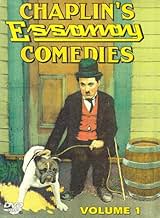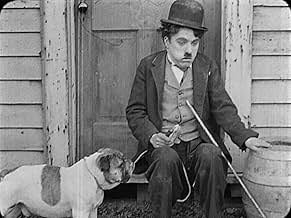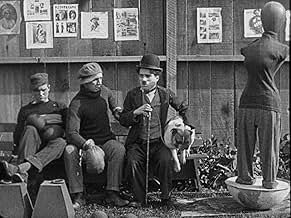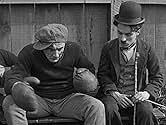NOTE IMDb
6,7/10
2,9 k
MA NOTE
Ajouter une intrigue dans votre langueWith his bulldog, Charlie finds a good luck horseshoe as he passes a boxing camp looking for someone who can take a beating. With the horseshoe in his glove, Charlie wins and earns a fight a... Tout lireWith his bulldog, Charlie finds a good luck horseshoe as he passes a boxing camp looking for someone who can take a beating. With the horseshoe in his glove, Charlie wins and earns a fight against the world champion.With his bulldog, Charlie finds a good luck horseshoe as he passes a boxing camp looking for someone who can take a beating. With the horseshoe in his glove, Charlie wins and earns a fight against the world champion.
- Réalisation
- Scénario
- Casting principal
Bud Jamison
- Bob Uppercut - Champion
- (non crédité)
Gilbert M. 'Broncho Billy' Anderson
- Enthusiastic Fan
- (non crédité)
Billy Armstrong
- Sparring Partner
- (non crédité)
Lloyd Bacon
- Second Sparring Partner
- (non crédité)
- …
Bill Cato
- First Sparring Partner
- (non crédité)
- …
Frank Dolan
- Second Stretcher Bearer
- (non crédité)
W. Coleman Elam
- Bit Role
- (non crédité)
Eddie Fries
- Bit Role
- (non crédité)
Daniel P. Kelleher
- Second Cop
- (non crédité)
Paddy McGuire
- Sparring Partner
- (non crédité)
Edna Purviance
- Trainer's Daughter
- (non crédité)
Jess Robbins
- Bit Role
- (non crédité)
Carl Stockdale
- Sparring Partner
- (non crédité)
Ben Turpin
- Ringside Vendor
- (non crédité)
Ernest Van Pelt
- Spike Dugan
- (non crédité)
Leo White
- Crooked Gambler
- (non crédité)
Avis à la une
Chaplin's third Essanay picture and he finally appears to have found his feet with the new studio. Chaplin's tramp, destitute and famished spots a sign offering money to act as a sparring partner. He watches as three men go in before him and return battered and bruised. Chaplin however has a trick up his sleeve or rather in his glove; a lucky horseshoe, which he uses to knock out his larger, more adept opponent. Spotting his potential a trainer prepares the slight Chaplin for a big fight against the champion Bob Uppercut (Bud Jamison) but Chaplin has other things on his mind, namely the trainer's daughter Edna Purviance.
I was so glad that this film was good. I was really disappointed with Chaplin's first two Essanay films His New Job and A Night Out. This is a real return to form. The idea was actually taken from a Fred Karno sketch that Chaplin performed before entering the movie industry. Perhaps one of the reasons for the film's success is that Chaplin knew what he was doing before he went in rather than partially making it up as he went along.
The film really shows its age with its inter-titles. There wasn't one occasion where I understood every word! But you have to remember that this film is 97 years old and language changes. Another thing that changes is people's attitudes and sensibilities towards kissing. It's hard to believe now but Hollywood once enforced a self censorship ruling that meant that no on screen kiss could last more than a couple of seconds. Although made in pre-code Hollywood, Chaplin got round this type of censorship by having his Tramp kiss Edna from behind a large beer bottle. It's a clever device that works around censorship.
The film is much slower and more measured than much of Chaplin's other work of the period and especially the work of Keystone. The opening scene in which Chaplin shares a hot dog with his equally starving dog is both very sweet and very slow and reminiscent of his later work. It's a complete opposite of his previous Keystone films.
The highlight of the film is undoubtedly the boxing. Watching Chaplin train in his trademark bowler hat is brilliant and the big fight itself is hilarious and extremely well choreographed. Chaplin and Jamison spend half the fight either falling over or in embraces, punching themselves in the face and the umpire obviously gets a few punches thrown his way too. Raging Bull this is not. You have to feel that the film is a precursor to Chaplin's massively successful City Lights which features his famous boxing scene. Another highlight is the fantastic makeup and over the top fake facial hair of the film's villain Leo White, a motif of Chaplin's early work. Without dialogue you are still always sure who the bad guy is with his deep dark eyes, pale face and enormous moustache.
This film is not up there with Chaplin's later work but shows great potential. It is a marked improvement on his earlier Essanay films and introduced a lot of action into his repertoire.
www.attheback.blogspot.com
I was so glad that this film was good. I was really disappointed with Chaplin's first two Essanay films His New Job and A Night Out. This is a real return to form. The idea was actually taken from a Fred Karno sketch that Chaplin performed before entering the movie industry. Perhaps one of the reasons for the film's success is that Chaplin knew what he was doing before he went in rather than partially making it up as he went along.
The film really shows its age with its inter-titles. There wasn't one occasion where I understood every word! But you have to remember that this film is 97 years old and language changes. Another thing that changes is people's attitudes and sensibilities towards kissing. It's hard to believe now but Hollywood once enforced a self censorship ruling that meant that no on screen kiss could last more than a couple of seconds. Although made in pre-code Hollywood, Chaplin got round this type of censorship by having his Tramp kiss Edna from behind a large beer bottle. It's a clever device that works around censorship.
The film is much slower and more measured than much of Chaplin's other work of the period and especially the work of Keystone. The opening scene in which Chaplin shares a hot dog with his equally starving dog is both very sweet and very slow and reminiscent of his later work. It's a complete opposite of his previous Keystone films.
The highlight of the film is undoubtedly the boxing. Watching Chaplin train in his trademark bowler hat is brilliant and the big fight itself is hilarious and extremely well choreographed. Chaplin and Jamison spend half the fight either falling over or in embraces, punching themselves in the face and the umpire obviously gets a few punches thrown his way too. Raging Bull this is not. You have to feel that the film is a precursor to Chaplin's massively successful City Lights which features his famous boxing scene. Another highlight is the fantastic makeup and over the top fake facial hair of the film's villain Leo White, a motif of Chaplin's early work. Without dialogue you are still always sure who the bad guy is with his deep dark eyes, pale face and enormous moustache.
This film is not up there with Chaplin's later work but shows great potential. It is a marked improvement on his earlier Essanay films and introduced a lot of action into his repertoire.
www.attheback.blogspot.com
'The Champion' is a nice short film by Charlie Chaplin and of course with Charlie Chaplin. Watching him I always admire his skills. I don't know if you can call it acting but whatever you call it he is great with it. This short starts as a real story but soon it can come to the moment where Chaplin can show his skills. This time in a boxing contest and the preparation before it. There are some very funny moments and most of it was not that predictable. That is the case very often in the shorts of Charlie Chaplin but not so much in this one. I also liked the way the music played together with the performances, it made the whole thing funnier. Definitely worth a watch.
This is one of 5 Chaplin that are on the first DVD of Chaplin's Essanay Comedies. In general, compared to volume 2, the shorts on volume 1 aren't as well-made--because the DVDs are arranged chronologically. Chaplin's skill as a film maker and actor appeared to improve through his stay with Essanay Studios.
This short is not great, but compared to the previous Essanay shorts, it is a major improvement. That's because this short is more like a mini-movie and is very plot-driven--something ALL great Chaplin shorts have in common. The final boxing sequence is funny but makes no sense--just turn off your brain and enjoy.
By the way,...I like the dog in the film. Dogs like this are cool.
This short is not great, but compared to the previous Essanay shorts, it is a major improvement. That's because this short is more like a mini-movie and is very plot-driven--something ALL great Chaplin shorts have in common. The final boxing sequence is funny but makes no sense--just turn off your brain and enjoy.
By the way,...I like the dog in the film. Dogs like this are cool.
Charlie Chaplin in the prize ring; his admirers will chuckle at the bare thought, and roar when they see the picture. The scenes in the training quarters are a steady laugh, but when Charlie faces his opponent in the roped arena, the fun is more than doubled. There have, doubtless, been burlesque boxing matches ever since the birth of the drama, but this one knocks them all out. It is a three-round "go" that grows in excitement and hilarity at every blow struck. While it must be admitted that Charlies wins the championship on a foul (with the help of his bull dog), everyone will be delighted with the result. A two-reel side-splitter. - The Moving Picture World, March 27, 1915
I saw the 20 minutes version. It ends with his bulldog entering the ring biting and Charles Chaplin knocking out his opponent in Round 20. I guess it's missing the romantic ending. I can understand that. This version is strictly a slapstick movie.
I like quite a lot of the slapstick. Of course, there is nothing funnier than his boxing sequence in 'City Lights' (1931). Here he's trying out several things. When he's boxing fodder, he puts a horseshoe into his glove. Then during the long boxing match, he's doing a lot of what would recognizable to most people who's seen the boxing match in 'City Lights'.
I like quite a lot of the slapstick. Of course, there is nothing funnier than his boxing sequence in 'City Lights' (1931). Here he's trying out several things. When he's boxing fodder, he puts a horseshoe into his glove. Then during the long boxing match, he's doing a lot of what would recognizable to most people who's seen the boxing match in 'City Lights'.
Le saviez-vous
- AnecdotesThe film was restored in 2014 through the Chaplin Essanay Project thanks to the financial support of the Niles Essanay Silent Film Museum.
- ConnexionsEdited into Chase Me Charlie (1918)
Meilleurs choix
Connectez-vous pour évaluer et suivre la liste de favoris afin de recevoir des recommandations personnalisées
Détails
- Date de sortie
- Pays d’origine
- Sites officiels
- Langues
- Aussi connu sous le nom de
- Charlie the Champion
- Lieux de tournage
- Société de production
- Voir plus de crédits d'entreprise sur IMDbPro
- Durée
- 31min
- Couleur
- Mixage
- Rapport de forme
- 1.33 : 1
Contribuer à cette page
Suggérer une modification ou ajouter du contenu manquant

































